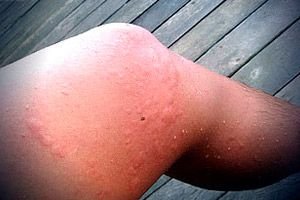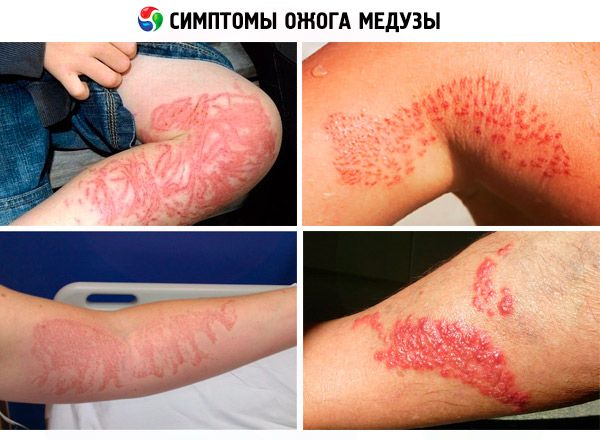
All iLive content is medically reviewed or fact checked to ensure as much factual accuracy as possible.
We have strict sourcing guidelines and only link to reputable media sites, academic research institutions and, whenever possible, medically peer reviewed studies. Note that the numbers in parentheses ([1], [2], etc.) are clickable links to these studies.
If you feel that any of our content is inaccurate, out-of-date, or otherwise questionable, please select it and press Ctrl + Enter.
Jellyfish burn
Medical expert of the article
Last reviewed: 07.07.2025

The tentacles extending from the hemispherical body of the jellyfish contain paralyzing poison. All jellyfish are poisonous to a greater or lesser extent; Portuguese man-of-war are considered to be among the most dangerous. A jellyfish sting can be quite painful. It is important to remember that they can sting not only in the water, so you should also avoid touching jellyfish that have washed up on the seashore.
Pathogenesis
Many jellyfish contain nematocides (stinging cells) in their bodies that produce the poison they need to obtain food and protect themselves. They also have nematocysts (small intracellular structures) - a capsule with a hollow thread twisted into a spiral inside. Touching a jellyfish causes an immediate reaction - it releases a poison through its stinging cells that has a nerve-paralytic effect, which is injected into the body. The cells with the poison remain on the skin even after the tentacles have been separated, continuing to affect it - as a result, a person experiences severe pain, which can develop into pain shock.
Symptoms jellyfish burn
The first sign of a jellyfish sting is severe pain, which can even exceed the pain of a sting from several wasps. Then, a jellyfish sting can manifest itself in the form of a rash on the skin, itching, and the appearance of large scars. Further symptoms depend on the intensity of the burn, as well as the type of jellyfish that stung. Among such manifestations:
- Vomiting with nausea;
- Muscle spasms and cramps;
- Diarrhea;
- Numbness of the body.

Complications and consequences
A jellyfish sting can cause anaphylactic shock. Other complications may include the following symptoms:
- The appearance of red spots on the skin;
- Feeling of anxiety;
- Swollen neck, tongue and face, as well as swelling in the area around the eyes;
- Hoarseness of voice;
- Breathing problems;
- Increased heart rate.
Who to contact?
Treatment jellyfish burn
What to do if you get stung by a jellyfish? First aid
If a jellyfish sting occurs, it is necessary to immediately provide the victim with first aid, which consists of the following priority measures:
- Pour water generously over the bitten part of the body to wash away any remaining tentacles and poisonous substance on the skin;
- Apply ice to the inflamed skin to reduce the intensity of pain;
- Immediately seek help from specialists so that the victim can receive qualified medical care using the necessary means and medications in such cases;
- It is also necessary to monitor the breathing and heartbeat of the victim, since in some cases the consequence of a jellyfish sting may be pain shock or a strong allergic reaction.
What to do in case of a jellyfish sting?
First, you need to get out of the sea immediately. Since most jellyfish are not so poisonous as to pose a danger to human life, you can relieve the victim of unpleasant sensations right on the shore - treat the area of skin with a burn. It should be taken into account that some categories of people may experience a more serious reaction (pain shock) to a bite - this applies to the elderly, children, allergy sufferers, and also those who have diseases of the respiratory or cardiovascular systems.
When the victim comes out of the water, you need to rinse (it should only be salt water or a soda solution, but not fresh water, because under its influence, nematicides are activated) and clean the area of the skin that was attacked by the jellyfish - remove the remains of the tentacles from it. At the same time, you need to remember that you can not touch the wound with bare hands - this will cause another burn. Therefore, you should use cotton swabs or napkins for cleaning.
If you have a first aid kit with ammonia (alcohol or apple cider vinegar can be used instead), it is recommended to treat the burn site with a compress - this method allows you to remove toxins from the damaged skin. Fresh human urine can reduce the impact of a jellyfish sting.
The victim is also advised to drink plenty of fluids.
After the patient has been given all the necessary first aid, he should be taken to a doctor to prevent the risk of developing unwanted consequences. This is a mandatory procedure, because there are very dangerous types of jellyfish, the bite of which can cause serious consequences or allergies.
It is also worth noting what not to do if you get a jellyfish sting:
- Treat the bite site with any oils or greasy cream;
- Disinfect the inflamed area using solutions containing alcohol, as well as brilliant green or iodine;
- Do not scratch, rub or touch the burnt area in general – you must not irritate the damaged skin.
Further Treatment for Jellyfish Sting
The bite site must be treated with a drug to reduce the effect of the poison. To do this, you need to use drugs aimed at eliminating itching and inflammation. Swelling is effectively removed by hydrocortisone cream, and itching is relieved by drugs that treat insect bites. Among such drugs are anti-inflammatory and antihistamines: Fenistil, Psilo Balsam, and Aloe Vera.
Medicines
Fenistil is used in case of itching of the skin (itching can have different origins, except for that caused by cholestasis), for example, in case of insect bites. Contraindicated in the following situations: high sensitivity to dimethindene or other components of the drug, prostate hyperplasia, closed-angle glaucoma; children under 1 month (especially premature babies). It is prescribed with caution in the 1st trimester of pregnancy, as well as during breastfeeding.
The drug is applied externally - 2-4 times a day. lubricate the damaged area. If a large area of skin is affected or the itching is very severe, oral forms of the drug should be used together with the gel.
Side effects of Fenistil include burning and dry skin. Sometimes itching and rash may occur.
Hydrocortisone ointment is used to treat skin diseases - atopic, simple and allergic dermatitis, eczema, pruritus, photodermatosis, erythroderma, as well as insect bites.
The ointment is contraindicated in the following cases: high sensitivity to the drug components, fungal, bacterial and viral skin diseases (such as mycosis and pyoderma), cutaneous tuberculosis, perioral dermatitis, wounds or ulcers, skin tumors, cutaneous syphilis, in the post-vaccination period, and in children under 2 years of age. It is prescribed with caution in diabetes mellitus, in the 1st trimester of pregnancy and during breastfeeding, as well as in case of systemic tuberculosis.
Application of hydrocortisone ointment – apply a thin layer of the preparation to the inflamed skin maximum 3-4 times a day. The treatment course lasts for 1-3 weeks. No more than 30-60 g of ointment can be used in 1 week.
Side effects of the drug include: skin rash. In case of prolonged use (especially when using hermetic dressings or applying to a large area of skin), systemic side effects may occur.
Folk remedies
There are several folk methods of treating a jellyfish sting.
The site of a jellyfish bite can be treated with a solution of salt, soda or ammonia (weak), after which a piece of ice, previously wrapped in a clean cloth, can be applied to it.
Take 1 part salt, 4 parts flour and add water (until a paste forms). Lubricate the burnt areas as generously as possible with the resulting mixture. Put a bandage on top. In an hour, the pain and itching will subside. Since it is quite difficult to remove such a paste from the skin (it dries during this period of time), it should be soaked first.
Tomato or lemon rings work well against inflammation – you need to tightly cover the damaged area of the skin with them.
Aloe can reduce the degree of skin damage (under the influence of this medicinal plant, the process of swelling of blisters stops). It should be cut, applied to the wound, and then bandaged.
Egg white is also considered a good folk method - it needs to be beaten and then applied to the burn site.
Sea buckthorn oil and goose fat effectively remove burns.
Another quality remedy is carrots, as they contain a lot of provitamin A. You should grate the carrots, then apply the resulting gruel to the burned areas of the skin.
Homeopathy
In case of a jellyfish burn, the victim should be given 1 granule of the homeopathic medicine Medusa 30 C as soon as possible. The scheme for further use of the drug should be discussed with a homeopath, because for each case an individual treatment is prescribed, which depends on the age of the victim, the severity of the burn and other factors. Therefore, you will need to consult a specialist.
To treat a jellyfish sting, use homeopathic gel Calendula - apply it to the affected area several times a day, allowing the medicine to be absorbed into the skin.
More information of the treatment
Prevention
As a preventive measure against jellyfish stings, the most important thing is to avoid contact with them. To do this, you need to follow some safety rules:
- Try not to touch a jellyfish floating in the water, as when calm it does not release its poisonous tentacles. If necessary, they are capable of stretching out over fairly large distances;
- It is not advisable to go into the sea after a storm, as there may be pieces of tentacles floating in the water;
- When diving, it is not recommended to touch anything underwater (even if you are wearing gloves).
 [ 14 ]
[ 14 ]
Forecast
A jellyfish sting, if treated promptly, in most cases passes quickly and without consequences for the victim. But there are also types of poisonous jellyfish that are deadly to humans, the bite of which can lead to death in a matter of minutes.

